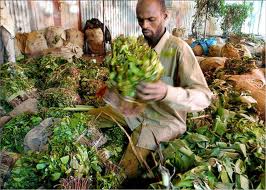Source: Transnational Institute
Series on Legislative Reform of Drug Policies Nr. 17
January 2012
By Axel Klein, Martin Jelsma and Pien Metaal
The globalisation of control and regulation of an ancient stimulant
In the context of a fast changing and well documented market in legal highs, the case of khat (Catha edulis) provides an interesting anomaly. It is first of all a plant-based substance that undergoes minimal transformation or processing in the journey from farm to market. Secondly, khat has been consumed for hundreds if not thousands of years in the highlands of Eastern Africa and Southern Arabia. In European countries, khat use was first observed during the 1980s, but has only attracted wider attention in recent years.
Discussions about appropriate regulatory systems and the implications of rising khat use for European drug policies4 should take cognizance of social, demographic and cultural trends, and compare the existing models of control that exist in Europe. Khat provides a unique example of a herbal stimulant that is defined as an ordinary vegetable in some countries and a controlled drug in others. It provides a rare opportunity to study the effectiveness, costs and benefits of diverse control regimes. As long as khat is legally produced and traded, it also allows for the views of stakeholders such as farmers and traders to be included in policy discussions.
KEY POINTS
• Where khat has been studied extensively, namely Australia, the UK and until recently the Netherlands, governments have steered clear of prohibition because the negative medical and social harms do not merit such controls.
• Strict bans on khat introduced ostensibly for the protection of immigrant communities have had severe unintended negative consequences.
• Khat prohibition has failed to further the integration, social incusion and economic prosperity of the Somali community.
• Assumptions about causal relations between khat use and the problems of a vulnerable minority with untreated mental health conditions need to be dealt with carefully and should not be used as a pretext for criminalising khat.
• Migrant communities and problematic users need a constructive engagement and targeted interventions. The criminalisation of a cultural practice will only intensify the problem that community leaders are seeking to address.
CONCLUSION
In several countries khat was prohibited after the active ingredients, cathine and cathinone were scheduled, without any investigation of feasibility, consequences or benefits of such a ban. Where khat has been studied most extensively, namely Australia, the UK and until recently, the Netherlands, governments have steered clear of prohibition. Not only does the evidence of khat related harm not merit such controls, but the negative consequences outweigh any benefits from reduced consumption.
The cost of khat controls can be summarized as criminogenic; reinforcing the isolation and vulnerability of immigrant populations, and impacting negatively on livelihoods and economic development in producer countries. The hoped for benefits of reduced khat consumption have not delivered social inclusion or economic prosperity in countries where khat has been banned. Indeed, migration patterns within the diaspora point towards movement from Scandinavia to Britain where opportunities are perceived as more promising. One of these is of course, the khat economy itself, with retail and catering providing a rare competitive advantage.
Khat related problems are tied to the underlying, structural vulnerabilities of the immigrant populations, and particularly the Somali community. This involves problems of cultural alienation, lack of professional skills and educational attainments, but also family fragmentation and poor mental health that resulted from the migration experience. These dovetail with the second dimension of problematic and intensive khat consumption by a minority of chewers. Post traumatic stress disorder, patterns of khat use in refugee camps, the ongoing crisis in Somalia as well as gender relations are important factors in this regard.
What migrant communities and problematic users need is constructive engagement and targeted interventions. The wholesale criminalisation of a cultural practice will only serve to intensify the very problem that community leaders are seeking to address.




 Creative Commons Attribution
Creative Commons Attribution